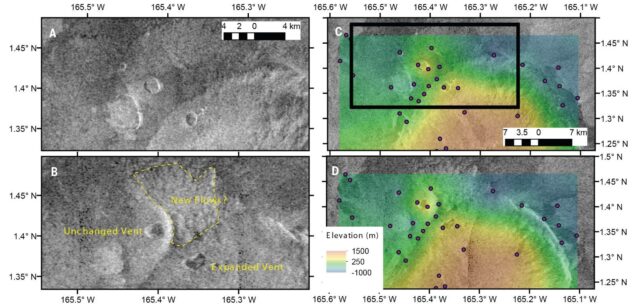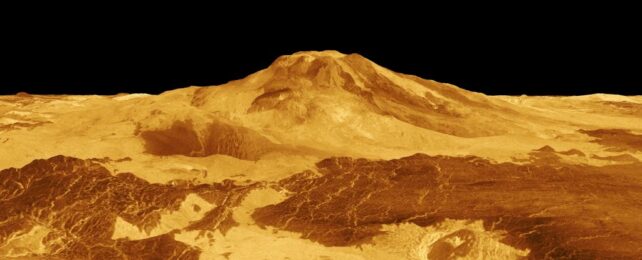We have exciting new evidence that Venus is geologically active.
Using radar images taken by the Magellan spacecraft during the early 1990s, scientists have found a volcanic vent that changed shape and grew over an eight-month period in 1991. It's one of the most compelling clues yet that volcanism is still active on Venus, shaping the planet's surface and atmosphere.
This has implications for how we interpret observations of our neighboring planet, including the detection of phosphine gas initially attributed to potential life, but that could also have been the result of volcanic activity.
"We examine volcanic areas on Venus that were imaged two or three times by Magellan and identify a ~2.2 km2 volcanic vent that changed shape in the eight months between two radar images," write geophysicist Robert Herrick of the University of Alaska Fairbanks and engineer Scott Hensley of NASA's Jet Propulsion Laboratory in California.
"We interpret these results as ongoing volcanic activity on Venus."
Venus and Earth have a lot of things in common; their size, mass, density, and composition are all very similar. But for two similar chunks of rock, they sure took different paths. Earth is moist, temperate, and crawling with life. Venus is dry, horrendously hot, and shrouded in a toxic, suffocating, and tempestuous atmosphere.
Another difference between the two planets is the lithosphere, the rocky outer shell containing the gooey molten interior. Earth's lithosphere is like a cracked eggshell consisting of multiple pieces, the tectonic plates, whose edges rub against each other. Most of Earth's volcanic activity takes place along these boundaries.
Venus's lithosphere is one complete shell, with no tectonic plates. This has raised questions about the planet's volcanic activity. Its young surface suggests volcanic resurfacing recently, but whether it is still volcanically active, and how volcanically active it is, have remained open questions.
Because of Venus's atmosphere, seeing its surface is not easy; it requires imaging techniques that can cut through the thick carbon dioxide. In addition, dedicated Venus probes are few and far between. The Japan Aerospace Exploration Agency's Akatsuki probe is the only one currently, and it's studying the planet's atmosphere, not it's surface.
Other probes have flown by Venus and taken images, but in order to understand any potential volcanism, you need something that can monitor the surface over time.
This is where Magellan comes in.
It spent just under 4.5 years orbiting Venus, using radar to image the surface for a large chunk of that time, between 1990 and 1992.
But the probe's orbit was elliptical, which means that the different angles with which it imaged Venus' surface made the resulting data unsuited to automated comparative analysis. This meant a human had to do it manually, a time-consuming and fiddly task.
"It is really only in the last decade or so that the Magellan data has been available at full resolution, mosaicked and easily manipulable by an investigator with a typical personal workstation," Herrick explains.
First, he narrowed down the data he needed to comb through by choosing sites previously identified as likely to be volcanically active. Then he manually sifted through the Magellan images, looking for changes in the landscape around these sites.

And he found something, close to two of the largest volcanoes on Venus, Ozza and Maat Mons. These volcanoes are comparable in volume to volcanoes on Earth, but flatter and more spread out. A vent on the north side of a shield volcano that forms part of Maat Mons noticeably changed shape between February and October of 1991.
Initially, the vent was nearly circular, with an area of about 2.2 square kilometers, which is a bit bigger than Monaco. In the later image, the shape was larger, about 4 square kilometers, and irregular. It also appeared to be nearly filled to the rim, possibly transforming into a lava lake, although it's unclear if the material inside it was still molten by the time of the second image.
The shape of the terrain around the vent changed, too, possibly as the result of fresh lava flows. Hensley conducted modeling and found that volcanic activity was likely.
It's possible that the vent collapsed on its own, in the absence of volcanic activity; but here on Earth, such collapses always occur as the result of volcanic activity, either at the site or nearby.
Combined with other recent studies, including close examinations of Magellan's data, the findings represent some compelling evidence for ongoing volcanic activity at Earth's nearest planetary neighbor. And some intriguing research opportunities for Venus probes currently in development.
"We can now say that Venus is presently volcanically active in the sense that there are at least a few eruptions per year," Herrick says.
"We can expect that the upcoming Venus missions will observe new volcanic flows that have occurred since the Magellan mission ended three decades ago, and we should see some activity occurring while the two upcoming orbital missions are collecting images."
The research has been published in Science.
